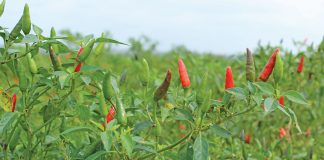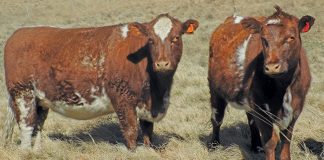
Photo: Glenneis Kriel
When Klein Karoo farmer Jolian du Preez bought his farm, Boetie Hutties, in 2017, his primary objective was to farm vegetables, vegetable seed, ostriches and sheep.
Today, vegetable seed is his most lucrative crop, while vegetables provide a good cash flow booster by generating income over shorter time frames. The production of these commodities is limited, however, by the availability of water and land, as the crops are rotated on 50ha under irrigation.
For this reason, diversifying into ostriches and sheep has made all the difference, as they utilise the 33ha of veld and land not under vegetables or vegetable seed production to boost farm income.
“We send the ostriches into the camps, then use the sheep to clean up what the ostriches have left behind,” says Du Preez.

The ostriches, in particular, were invaluable during the drought, which had already started in the region before he bought the farm, but started affecting his operations significantly from 2019.
“When I said I wanted to buy a farm around here, Amie Snyman, who is now one of my neighbours, went with me to look at some farms. Together, we decided that Boetie Hutties was the best buy, as it has borehole water and receives water from the Olifants and Nels rivers.
“This means it still has [access to] a little water, even during times of drought,” he explains.
On the downside, the farm, which is near De Rust, is home to more than 15 families, many of whose members are retired or work on neighbouring farms.
“Having so many people who don’t work on the farm but live on it can present social challenges. In an ideal world, on-farm housing should be reserved for people and their households who work on the farm.”
Settling in on the farm
Having a farming background, Du Preez knew the importance of having a well-established market before producing a crop. Even before the farm was in his name, he secured a contract to supply a school-feeding programme with vegetables such as carrots, cabbage and butternuts.
A breakthrough came in 2019, when he managed to sign a contract to supply Freshmark with green peppers. Unfortunately, the drought and COVID-19 put an end to the deal.
“I stopped supplying Freshmark after suffering huge losses because of COVID- 19-related logistical challenges: the trucks didn’t collect or deliver on time. In addition, availability of water decreased dramatically after that. But I hope to rekindle the agreement once our water reserves have returned to normal,” he says.
In another breakthrough, Du Preez secured a deal to supply vegetable seed to Klein Karoo Seed Production.
“They’ve really gone out of their way to help me succeed by providing production advice and support. When I felt like giving up, their managing director, David Malan, told me they were behind me and believed in me, which kept me motivated,” he says.
Unfortunately, his seed production had to be limited to 5ha of onion seed because of the drought, and this was downscaled even further to a mere 1ha. Once the drought is completely broken, however, he will be able to produce onion and carrot seed on 8ha to 10ha.
To prevent a build-up of soil diseases, Du Preez rotates vegetable seed and lucerne, and avoids planting the same crop on the same land for at least four years.
Along with most farmers in the region, he plants the SA Standard lucerne cultivar. He adds that although lucerne is fairly hardy, he had to resow his lands several times to maintain a good stand during the drought.
The drought also affected sheep production on Boetie Hutties. After buying the farm, Du Preez purchased 60 ewes, and was forced to reduce their number to 35 because of the dry conditions.
“I had to limit the impact of the sheep on the veld. Our carrying capacity is about 10 sheep/ ha under normal conditions,” he explains.
The time had come for the ostriches to shine.
First batch of ostriches
Although ostriches don’t take as heavy a toll on veld as sheep do, they are far more challenging to farm, says Du Preez. Fortunately, he knew what to expect from the start, having worked with the birds as the manager at Waaikraal, a community farm on the outskirts of Oudtshoorn.
He began in 2018, starting small by buying and raising 300 ostrich chicks on contract for an ostrich farmer in the region. The farmer supplied him with feed, medicine and advice.
Thereafter, he applied for a permit to produce slaughter ostriches and received funding and 400 day-old chicks from the Western Cape Department of Agriculture (WC agriculture department) in 2020.
In 2021, Cape Karoo International supplied him with 600 chicks, of which he kept half on the farm and sent half to an outgrower in Beaufort West to spread his geographical risk.
These include climatic events as well as the danger of an avian influenza outbreak, which can cause large-scale mortalities and result in a production unit being placed under quarantine.
“I decided to use this grower because he practises good stockmanship with his sheep. The arrangement is working well, but he lost a few ostriches when he left the farm to assist in a locust eradication effort. To prevent this from happening again, I asked someone from Beaufort West to check up on production daily, as I can only get there once or twice a week,” says Du Preez.
The grower returns the ostriches to Du Preez when they reach approximately 45kg each.
Further breakthroughs
Du Preez’s contract with Cape Karoo International stipulates that he must supply 600 birds a year. To achieve this, he starts with between 800 and 1 000 chicks.
“You can work on a loss of about 30%, as ostriches are extremely sensitive to environmental stressors. We suffered our biggest losses during a freak hailstorm in October last year,” he says.
He sells the ostriches once they reach a weight of 90kg, usually at 12 to 14 months of age.
“You can’t wait for prices to improve before selling the birds, as there’s no telling what the market will do. It’s best to sell them once they reach 90kg to prevent further feeding costs eating into your profits,” says Du Preez.
Much research has been conducted and manuals written to guide ostrich producers. Du Preez says that although these give valuable insights and advice, producers need to adapt the information to their conditions and circumstances.
“The South African Ostrich Business Chamber and its veterinarian, Dr Adriaan Olivier, have been a huge aid in helping to streamline production practices for my needs and when I reach a dead- end. But it’s an ongoing process; ostriches tend to throw a curve ball as soon as you think you have things under control.”
He adds that good stockmanship, attention to detail, patience and a love for the animals are equally crucial to success. They involve insight into animal behaviour and the skills to work and manage livestock animals in a stress-free way.
“In the case of ostriches, a good stockman will appreciate how vulnerable the chicks are, and so check up on them regularly, even overnight. When chicks huddle together, for example, it’s a sign that they’re cold, and it could lead to bruising and mortalities. This should be prevented by raising the temperature.”
An ostrich farmer also needs to start out with good production material, Du Preez stresses: this means day-old chicks of good genetic lineage obtained between September and November. He buys his chicks from the Oudtshoorn Research Farm, which belongs to the WC agriculture department and is known for its good ostrich genetics.
The only downside with this supplier is that the birds are available only in batches of 30 to 50, whereas he would have preferred to take batches of 100 or so birds at a time to simplify record-keeping and production management.
Overcoming obstacles
The WC agriculture department has been supporting Du Preez by supplying him with infrastructure to take his business to a commercial level, as well as funding to help cover the cost of feed, seed, fertiliser and other inputs.
He says, however, that the wheels of government turn slowly, a reality he learnt while working at Waaikraal, so it’s necessary to order inputs at least two months in advance to ensure they arrive in time.
“Applications need to be duplicated and approved more than once, which is understandable because of all the corruption in the country. The red tape, unfortunately, causes a lot of stress, especially for farmers who have never dealt with government before.”
Du Preez urges new farmers to build up networks and attend information days as far as possible. He also advises against working in isolation.
“Farmers help one another […], but you should then also bring something to the table. My neighbour, Billy Kleyn, for instance, has helped to rid our streams and land of obstructions. I, in turn, allow his dairy cattle to graze my lucerne land after it has been cut,” he says.
Along with this, the support of one’s family is crucial. “Farming is a hard life, requiring long hours of work and bringing a lot of uncertainty, especially during times of drought.
“I also had to cash in my pension fund to buy this farm. I wouldn’t have been able to realise this dream if it hadn’t been for the support of my wife Rosina, who works full-time as a nurse to help keep the farm running,” he says.
Email Jolian du Preez at [email protected].











